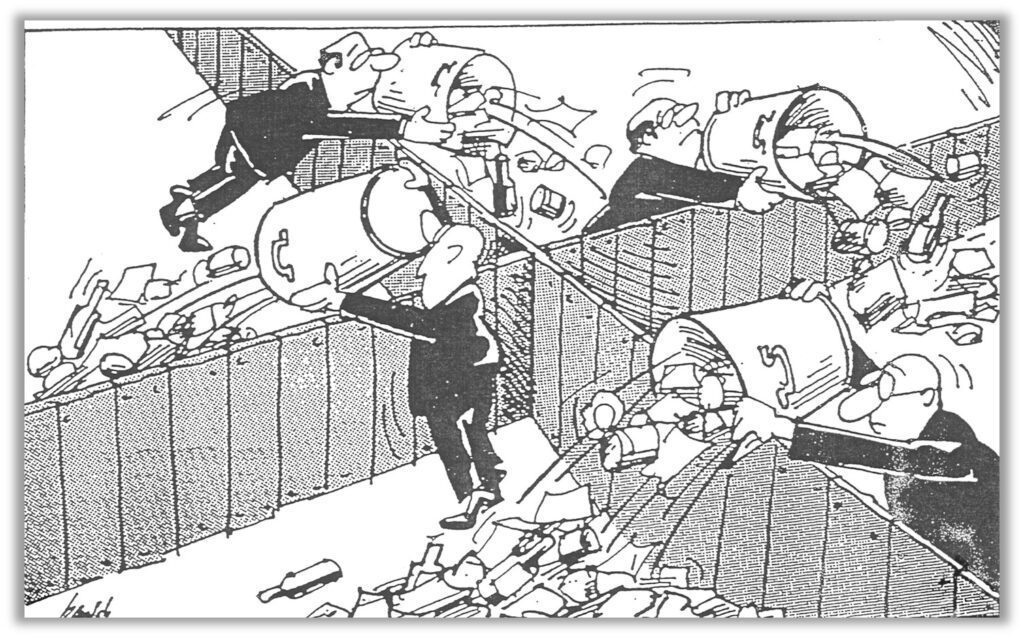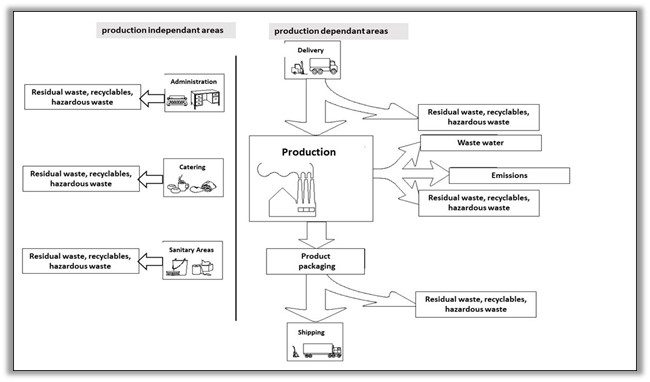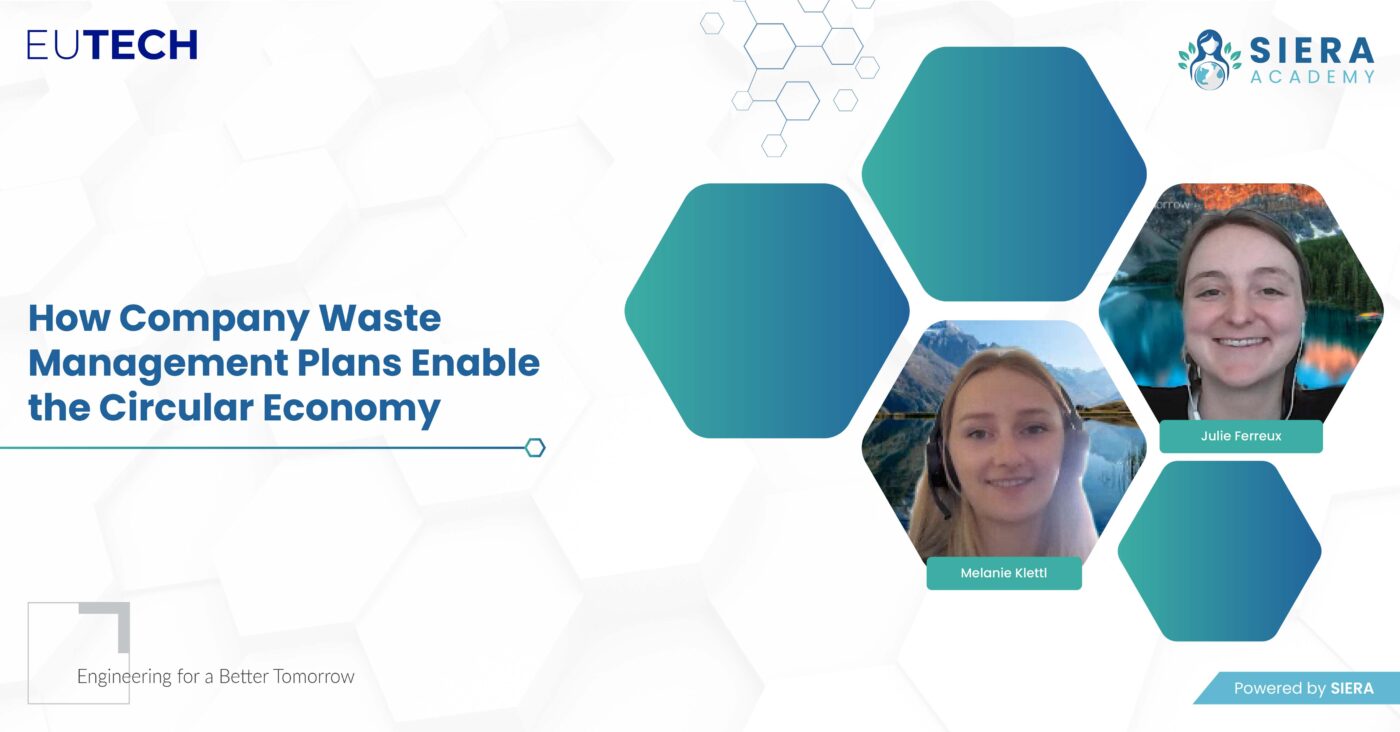Every company produces waste — but not every company knows what to do with it in a world that’s rapidly shifting toward sustainability and circularity. As Europe pushes forward with ambitious climate and resource-efficiency goals, corporate waste is no longer just a byproduct of doing business. It’s now a central issue of compliance, cost-efficiency, and corporate responsibility.
The SIERA Academy Impact Series Webinar, held on June 3, 2025, tackled this issue head-on with the session titled: “How Company Waste Management Plans Enable the Circular Economy.”
The webinar explored how companies can rethink and redesign their waste management practices — not just to comply with evolving EU regulations like ESRS E5, the EU Circular Economy Action Plan, and the Waste Framework Directive, but to unlock real environmental and business value.
Speakers and participants focused on practical strategies: how to set up effective waste management plans, measure environmental performance, reduce residual waste, and turn linear processes into circular ones. The event brought to light a simple truth — what a company throws away says a lot about how sustainable it truly is.
In this blog, we’ll walk through the biggest takeaways from the session: the challenges companies face, the legal and regulatory landscape, the goals waste management plans must achieve, and the real-world insights shared during the panel discussion. But first let’s get a basic overview on the on the subject of corporate waste and waste management.
Understanding Waste: Definitions, Classifications, and Management Basics
Before any company can build a compliant or circular waste strategy, it must understand the basics: What qualifies as waste? How is it classified? And what does effective waste management actually involve?
These foundations—clearly laid out during the webinar—are critical to creating structured, measurable waste management plans.
What Is Waste?
Legally, waste is defined under the EU Waste Framework Directive (Directive 2008/98/EC) and the German Kreislaufwirtschaftsgesetz (KrWG) as:
“Any substance or object which the holder discards or intends or is required to discard.”
This definition may seem simple, but its implications are far-reaching. It determines how companies identify materials as waste, apply legal responsibilities, and classify processes under environmental law.
Three Key Waste Categories
The circular economy doesn’t treat all waste equally. Companies need to recognize and separate the following waste types to handle them responsibly and cost-effectively:
| Waste Type | Description | Examples |
| Recyclables | Waste suitable for recovery, reprocessing, or reuse | Paper, cardboard, glass, metals, plastic, compostable waste |
| Hazardous Waste | Waste that is toxic, flammable, carcinogenic, or environmentally dangerous | Batteries, solvents, chemicals, paint, electronics |
| Residual Waste | Waste that cannot be recovered or reused and must be sent for final disposal | Diapers, food-contaminated waste, sweeping debris |
Failing to classify waste correctly increases legal risks and results in inefficient resource use.
What Does Waste Management Include?
Under the Waste Framework Directive, waste management is defined as a comprehensive process that spans the entire lifecycle of waste. It includes the collection, transport, recovery (such as sorting and recycling), and disposal of waste.
It also involves the supervision of these operations, the after-care of disposal sites, and any broker or dealer actions taken as part of the waste chain.
In other words, waste management is not just about removal—it’s about tracking, documenting, and optimizing each step to reduce impact and improve efficiency.
The Waste Hierarchy: From Disposal to Prevention
The EU’s waste hierarchy ranks waste treatment options by environmental priority. At the top is waste prevention, followed by reduction, reuse, recycling, and recovery.
Only after these options are exhausted should waste be treated or disposed—with disposal considered the least favorable.
This hierarchy is not just a guideline—it shapes legal requirements, funding eligibility, and long-term sustainability goals. Every company’s waste plan is expected to follow this structure.
What Is a Waste Management Plan in Companies?
A waste management plan (WMP) isn’t just a checklist—it’s an internal policy and control system. Its core objectives include:
- Preventing and reducing waste at the source
- Separately collecting recyclables and hazardous waste
- Ensuring safe transport, pre-treatment, and disposal
- Minimizing environmental impact and operational costs
- Monitoring and reporting every waste stream
The WMP becomes the backbone of a company’s environmental performance, making circularity measurable and traceable.
Why Waste Management Plans Matter — And What Happens Without Them
Without a structured waste management plan, companies expose themselves to both regulatory and operational risks. Legal requirements under the EU Waste Framework Directive and national laws like KrWG may be missed, leading to fines or reputational damage.
Operationally, waste is often handled inefficiently—inside and outside the company. Poorly designed production processes, outdated technologies, and unclear responsibilities result in excessive waste, high disposal costs, and missed recovery opportunities.
Crucially, without a plan, companies lack the data to identify where waste could be reduced, reused, or recycled. This makes it nearly impossible to improve environmental performance or control costs. Instead of enabling circularity, the system stays reactive—and expensive.

1.1. Graphical representation of waste mis-management
A waste management plan turns this around by providing structure, visibility, and a path toward compliance and cost savings.
Challenges – Waste Management in the Corporate Landscape
Despite growing awareness, companies across Europe still face significant hurdles when implementing effective waste management strategies. These challenges are not just operational—they are systemic, financial, and regulatory.
One of the most pressing issues is excessive production waste, which often stems from poorly designed processes, outdated technologies, and inefficient material usage. In the absence of data-driven waste tracking, many organizations lack visibility into waste generation patterns, making it difficult to identify opportunities for reuse, recycling, or reduction.
Moreover, the high upfront costs of adopting modern waste technologies, conducting internal audits, or retraining staff often discourage investment—particularly among small and medium-sized enterprises (SMEs). The uncertainty around return on investment further adds to the hesitation.
Regulatory complexity compounds the issue. While the EU Circular Economy Action Plan and the Waste Framework Directive establish ambitious guidelines, member state variations in interpretation and enforcement lead to compliance uncertainty. Misinterpretations or delays in implementation can result in legal penalties or reputational damage.
Ultimately, without a structured waste management plan, companies risk not only falling short of legal obligations, but also missing out on the economic and environmental benefits that circularity offers.
Regulatory Implications in the EU for Waste Management
Waste management is a legal obligation under EU law, not just a sustainability initiative. Key regulations like ESRS E5 require companies to report how they manage resource use and contribute to circularity.
The EU Taxonomy Regulation connects waste practices with access to green finance, while the Packaging Directive and Single-Use Plastics Directive regulate how materials like plastic, paper, and aluminum are produced, used, and recovered.
Foundational laws such as the Waste Framework Directive and Landfill Directive ensure safe treatment, disposal, and reduction of landfill waste—especially for hazardous and biodegradable materials.
Together, these directives demand structured, transparent waste strategies aligned with both compliance and sustainability goals
How is a Waste Management Plan for Companies Created?
Designing an effective Waste Management Plan (WMP) isn’t a one-size-fits-all approach—it requires companies to carefully assess their current situation, identify operational gaps, and implement tailored measures. The SIERA Academy webinar walked participants through this structured process, highlighting how a well-built plan serves not only regulatory compliance but also circularity and ESG outcomes.

1.2 Different types of waste and their sources in corporate operations
1. Assessing the Current Situation
Companies must begin by analyzing waste sources, quantities, and types across departments—from production to administration. This includes mapping how waste is collected, transported, and managed both inside and outside the company. Costs must be tracked to uncover inefficiencies.
2. Identifying Gaps
Gap analysis follows next. It uncovers deficiencies that prevent waste avoidance, recycling, or responsible disposal. These gaps may arise from legal non-compliance, organizational weaknesses, or a lack of recovery infrastructure. They are categorized by location, impact size, and underlying cause.
3. Developing an Action Plan
Once gaps are identified, the next step is to create a catalogue of actionable measures. These range from technical upgrades (e.g., container systems for separate collection) to legal and organizational changes (e.g., updated waste handling guidelines, clear responsibility assignments). The measures are evaluated based on time and cost requirements—classified as short-, medium-, or long-term, and low-, medium-, or high-cost.
4. Structuring for Implementation
Each measure is then broken down into phases—what needs to be done, who is responsible, and how the change will be implemented. This ensures accountability and traceability at every stage.
5. Periodic Review and Update
A WMP is not static. To remain effective, it should be reviewed and updated every 3 to 5 years, incorporating new regulations, technologies, and business realities.
By following this methodology, companies create a living framework that not only minimizes environmental impact but also optimizes cost, improves regulatory standing, and supports the circular economy transition.
Case Study: How a Corporate Waste Management Plan Fuels Circular Economy
A practical case study was shared during the webinar to illustrate how structured waste management planning directly contributes to the circular economy.
Structured Methodology with Departmental Checklists
The company began by identifying the current waste generation situation across key departments:
i) Administration, ii) Production, iii) Sanitary Areas, iv) Catering, v) Purchasing, vi) Data Management
Each department followed a checklist-based assessment to track waste types and quantities. For example, in the administration office:
- Each staff member used approximately 1 plastic bottle/day, 10g of plastic, and 10 sheets of paper.
- Annually, this added up to 1 ink cartridge, 1 stamp, 2 folders, and 5 pens per employee.
Gap Analysis and Action Planning
After the initial situation analysis, the company:
- Performed a gap analysis to evaluate inefficiencies and legal risks.
- Created an action plan to implement separate collection, reduce paper/plastic usage, and optimize purchasing.
Before and After Implementation
The waste management plan led to measurable improvements:
| Status | Key Observations |
| Before | High waste volume, lack of segregation, inefficient procurement, unclear responsibilities. |
| After | Source-separated waste streams, reduced volume of single-use plastics, informed purchasing policies, staff awareness raised. |
Benefits Realized
The implemented waste management plan delivered multiple benefits:
- Environmental: Reduced landfill contributions, saved resources, and lower pollution.
- Economic: Cost savings and groundwork for EPR (Extended Producer Responsibility) compliance.
- Legal: Fulfilled regulatory obligations, especially for hazardous waste, packaging, and ESG frameworks.
- Operational: Systematic data-driven understanding of waste streams.
This case highlights the importance of detailed departmental data, gap analysis, and cross-functional action planning. A well-structured waste management plan becomes not just a compliance document—but a foundation for corporate circularity, cost savings, and legal readiness.
Take the Next Step with SIERA
At SIERA Alliance, we support businesses in transforming waste management from a compliance burden into a strategic advantage. Whether you’re an SME looking to create your first Waste Management Plan or a larger corporation aiming to align with the EU Waste Framework Directive, and circular economy targets, our solutions are designed to meet your needs.
Our environmental engineering team helps companies move from fragmented waste practices to data-driven, legally sound, and cost-effective systems. We guide you in:
- Conducting detailed waste assessments across departments
- Classifying recyclables, hazardous, and residual waste according to KrWG and EU law
- Developing company-specific Waste Management Plans with actionable steps
- Meeting Extended Producer Responsibility and ESG reporting obligations
- Training your workforce to embed sustainable routines in daily operations
Additionally, with SustainSuite – part of SIERA, companies can visualize waste flows, generate compliance-ready reports, and track progress in real time—making environmental performance both measurable and manageable. Book a free demo now.
In a regulatory landscape where sustainability is no longer optional, SIERA Alliance provides the expertise, tools, and support to help your business stay ahead.
Contact us to learn how our solutions can help your company reduce environmental impact, meet legal standards, and transition toward a truly circular economy.







